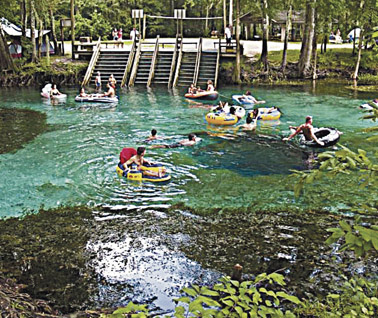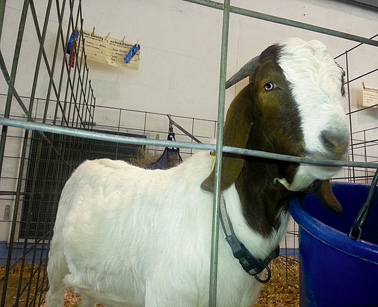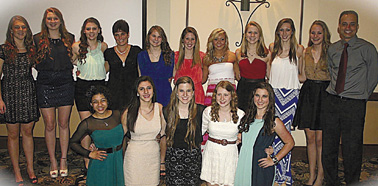
MARK LONG/Photo special to Alachua County Today
Families gather at Ginnie Springs near High Springs for some relaxation in the water. Researchers looked at the economic impact of several public and private springs to measure how much money they bring into the area.
ALACHUA COUNTY – Every summer for seven years, she would drive her daughters from Clearwater to High Springs.
It was the 90s, and Camp Kulaqua in High Springs was a beautiful place for Barbara Ferguson and her kids to spend their summer.
She recalls that there used to be docks all the way around, rope swings, and a huge inner tube fit for two people in the spring. There was even a diving board.
“The kids used to jump off the diving board and onto the tube, catapulting the other person off the other side,” she said.
The camp was surrounded by the Hornsby Springs, one of the gorgeous local flowing springs.
“I was the parent in the springs,” she said.
In the last 10 years, Ferguson said that one day the spring just stopped flowing. Camp Kulaqua is now a camp without a spring.
“It broke my heart,” said Ferguson, who is a board member of the environmental group Save Our Suwannee.
The springs were one of the reasons Ferguson left her home in Clearwater to move to Gainesville.
“I fell in love with the springs. We would go camping. It was beautiful.”
Now, Ferguson only has one word to describe Hornsby Springs.
One word, repeated three times.
“Gone, gone, gone.”
Over the last 50 years, the increase of water permits given by legislatures to industries and farmers has resulted in the ground levels to drop at least 40 feet, which continues to reduce the flow of water into the springs, Ferguson said. We cannot continue on the course we are on, unless we don’t want to have any springs, she added.
“Subsidies need to be used more wisely, to plant the right crops in the right places,” she said.
Ferguson said the water policy has always been in favor of developmental agriculture, which has been bad for the springs.
But, now, “it’s been bad on steroids,” she said. “The water is barely flowing, it is wimping along. There is not enough water, so there is little ground pressure underground to push through to the springs,” she said.
If the region loses its springs, the property values of homes will go down, because many people move here to be close to them
“The problem with most of our springs is over-withdrawal from the aquifers that feed them, lack of rainfall and increasing pollution from fertilizers and wastewater treatment plants,” said Annette Long, president of Save Our Suwannee.
That is why Ferguson got involved with Save Our Suwannee, a non-profit organization aiming to help raise awareness to the public and protect the water quality and quantity in the Suwannee Basin. The basin is made up of the springs that feed the Suwannee River and the Santa Fe River in North Central Florida. Recently, the board, made up of nine members, has been in contact with two economists from the University of Florida, Allen W. Hodges and Tatiana Borisova, to create a presentation to raise awareness of the economic benefits of the springs. Because the economy has been such a pressing issue in the legislature, they want to make a presentation that will appeal to the legislators based on the economic value that the springs bring to the region.
The research that Borisova and Hodges are undertaking will not be finalized until May. This impact study will be finished in June. For now, they are going through the process to help achieve the goal of Save Our Suwannee.
“The focus of the project is to estimate the economic interest in the area,” said Borisova, an assistant professor and extension specialist specializing in water economics and policy in the Food and Resource Economics Department at the University of Florida.
She and Hodges, along with a team of researchers, are developing a presentation on the project, which focuses on the economic contribution of eight public springs as well as some private springs.
The project consists of an input and output model to help display the contribution of the springs in the region. Existing information about the visitors’ region, the new money that it is bringing into the region from the outside, the number of jobs brought into the region and the goods and products used in recreation from the springs are factors the two are analyzing, Borisova said.
“There is a concern for this treasure we have here, and for decision makers, we need to have numbers for the economy to measure the contribution of the springs to the region, and we already see that there is a connection, and the region would likely suffer without it,” Borisova said.
Borisova said that she and Hodges have interviewed businesses around the cities and the local chamber of commerce to verify their estimates. Using the data collected from that and existing studies, Borisova hopes that they will come out with a regional gross domestic product (GPD) that will help their case when presenting to legislatures.
“The regional GPD will establish a relationship to tourism and an established value from the springs recreation,” Borisova said. She hopes this will then measure the total value of the springs.
Ferguson has many memories of the springs, which she said is important for action. “You need long-term memories to have long-range visions, and the legislators have short-term visions,” she said. That is why she wants the numbers to help convince them to adjust their ways to conserve water, instead of continuing to use up all the water from the springs.
“The outside money coming in is critical to our point, because people do come from all over to see the springs,” said Annette Long, president of Save Our Suwannee.
She said the presentation created by the research from Hodges and Borisova will be presented to local officials, business leaders and the public.
“We want to bring this info straight to them instead of them coming to us,” Long said.
Long said that the organization wants to show the legislature that, even though their goal is to create jobs and help the economy, the springs brings in money just by being there. They also flow fresh water into Cedar Key, which is essential for the oysters and the clams that are there for business.
“We are trying to make the point that the springs are essential to our way of life as well as to small businesses in the rural North Florida region,” Long said.
Save Our Suwannee is not blaming agriculture and industry, Ferguson said. She explained that the need for the springs is equally as important as the need for agriculture and industry.
“We need both,” she said. However, she said that there needs to be adjustments for a low-environmental impact in the development for the agriculture. “If my bank account is going low, I’ll turn off the cable,” Ferguson said. She wants legislatures to make adjustments so that we don’t run out of water and the springs can still flourish.
“We need to join arms and solve this together,” she said.
# # #
Email berickson@
alachuatoday.com
 GAINESVILLE – The Alachua County Youth Fair and Livestock Show kicked off last Thursday and concluded on Tuesday, March 11. Featuring a wide array of activities teaching youngsters about livestock and agriculture, the event drew in huge crowds throughout its six-day run.
GAINESVILLE – The Alachua County Youth Fair and Livestock Show kicked off last Thursday and concluded on Tuesday, March 11. Featuring a wide array of activities teaching youngsters about livestock and agriculture, the event drew in huge crowds throughout its six-day run. 

 Marc Okes, 8, who has brain cancer, had a wish to go on a motorcycle ride. When he and his mother arrived at the Harley-Davidson shop in Gainesville, a crowd of riders ande police officers were there to take them on a motorcycle ride. Pictired are Marc and his mother as they ride through Alachua on Monday,March 10. The local Make-A-Wish foundation helped make the dream come true for
Marc Okes, 8, who has brain cancer, had a wish to go on a motorcycle ride. When he and his mother arrived at the Harley-Davidson shop in Gainesville, a crowd of riders ande police officers were there to take them on a motorcycle ride. Pictired are Marc and his mother as they ride through Alachua on Monday,March 10. The local Make-A-Wish foundation helped make the dream come true for 

